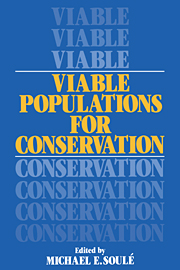Book contents
- Frontmatter
- Contents
- List of contributors
- Preface
- 1 Introduction
- 2 The demography of chance extinction
- 3 Extinction models and mammalian persistence
- 4 Minimum viable population size in the presence of catastrophes
- 5 Minimum viable populations: coping with uncertainty
- 6 Effective population size, genetic variation, and their use in population management
- 7 Spatial structure and population vulnerability
- 8 Managing critically endangered species: the Sumatran rhino as a case study
- 9 The role of interagency cooperation in managing for viable populations
- 10 Where do we go from here?
- Index
4 - Minimum viable population size in the presence of catastrophes
Published online by Cambridge University Press: 21 January 2010
- Frontmatter
- Contents
- List of contributors
- Preface
- 1 Introduction
- 2 The demography of chance extinction
- 3 Extinction models and mammalian persistence
- 4 Minimum viable population size in the presence of catastrophes
- 5 Minimum viable populations: coping with uncertainty
- 6 Effective population size, genetic variation, and their use in population management
- 7 Spatial structure and population vulnerability
- 8 Managing critically endangered species: the Sumatran rhino as a case study
- 9 The role of interagency cooperation in managing for viable populations
- 10 Where do we go from here?
- Index
Summary
There are two broad concepts of a minimum viable population (MVP) size. The first is a genetic concept, based on the rate at which genetic variation in a population is lost, and hence fitness decreased, through random genetic drift. The second is a demographic concept and is concerned with the probability of complete extinction of a population through random demographic forces. Although at an overall level these concepts are related, since inbreeding decreases fecundity and increases the death rate, present theory treats these as distinct concepts, since normal practice has been to assume the population size constant in defining and calculating the genetic MVP. For convenience, we also preserve this distinction in this chapter, and note that until a generalized theory covering both concepts is attempted, confusion may arise by the loose transfer of a numerical value of the MVP from the genetic to the demographic case, particularly the genetically derived values offered by Franklin (1980) and Soulé (1980).
For each of these two MVP concepts, the numerical value for the MVP eventually reached will depend on two assumptions. The first is the criterion chosen to define an MVP; for example, using the demographic concept, the size of the population which guarantees 95% probability of survival for y years clearly depends on the value chosen for y.
- Type
- Chapter
- Information
- Viable Populations for Conservation , pp. 59 - 68Publisher: Cambridge University PressPrint publication year: 1987
- 46
- Cited by



